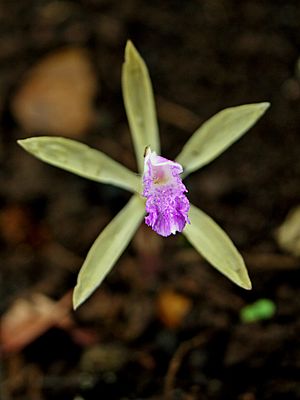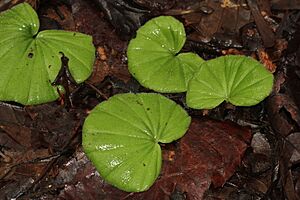Trembling nervilia facts for kids
Quick facts for kids Trembling nervilia |
|
|---|---|
 |
|
| Nervilia crociformis near Mahabaleshwar | |
| Scientific classification | |
| Genus: |
Nervilia
|
| Species: |
crociformis
|
| Synonyms | |
|
|
The Nervilia crociformis, also known as the trembling nervilia or round shield orchid, is a small plant. It is a type of orchid that grows in the ground. You can find it in parts of South Asia, Southeast Asia, New Guinea, and northern Australia.
This orchid has a single green flower that does not last very long. It has a special white part called a labellum. After the flower fades, a round leaf grows from the base of the plant. This leaf lies flat above the ground.
What Does It Look Like?
The trembling nervilia is a ground-dwelling plant. It is a perennial herb, meaning it lives for more than two years. It is also deciduous, so it loses its leaves at certain times. These orchids often grow in groups called clonal colonies. Only a few plants in a group will flower each year.
Each plant produces one green flower. The flower is about 25 to 30 millimeters (1 to 1.2 inches) long. It is also about 30 to 35 millimeters (1.2 to 1.4 inches) wide. The flower grows on a stem that is 40 to 80 millimeters (1.6 to 3.1 inches) tall.
The flower has parts called sepals. These are 16 to 19 millimeters (0.6 to 0.7 inches) long and about 2 millimeters (0.08 inches) wide. The petals are similar but a little shorter. The labellum, which is the special lip-like part, is white. It is 15 to 18 millimeters (0.6 to 0.7 inches) long. It has a wide fringe and small, hairy bumps called calli.
The flower only stays open for two or three days. After the flower is gone, a single leaf grows. This happens even for plants that did not flower. The leaf is dark green and mostly round. It is 40 to 70 millimeters (1.6 to 2.8 inches) across. It has about ten veins that spread out from the center.
In Australia, these orchids usually flower between November and December. In India, they flower from May to June.
How It Got Its Name
The trembling nervilia was first officially described in 1846. Two scientists, Heinrich Zollinger and Alexander Moritzi, gave it its first name. They called it Bolborchis crociformis. They wrote about it in Moritzi's book, Systematisches verzeichniss der von H. Zollinger.
Later, in 1978, another scientist named Gunnar Seidenfaden changed its name. He renamed it to Nervilia crociformis, which is the name it has today.
Where It Lives
You can find Nervilia crociformis in many places around the world. It grows in Tropical Africa and Southern Africa. It is also found on islands in the western Indian Ocean. Other places include Taiwan, the Indian subcontinent, and Indochina. It also lives in Malesia, New Guinea, Queensland in Australia, New Caledonia, Samoa, and Vanuatu.
This orchid prefers to grow in moist deciduous forests. It also likes the edges of rainforests.


